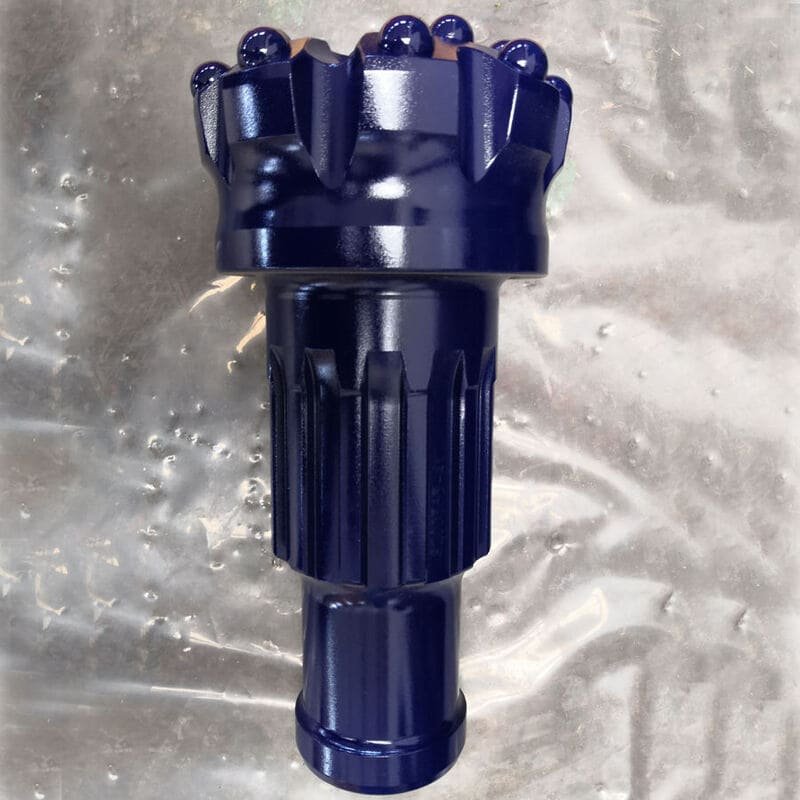Have you ever found yourself trying to time a purchase just right, hoping for that perfect balance between quality and cost savings?
The best time to buy DTH drill bits is typically at the end of the fiscal year or during the off-season, when manufacturers offer discounts and deals to clear inventory or boost sales figures.
I've often found myself in situations where timing a purchase could make all the difference. It's like the thrill of shopping for winter coats in July or finding those perfect holiday gifts during summer sales. While fiscal year-end and off-season purchases are generally savvy moves, it's also wise to keep an eye on industry events and new product launches. These moments can offer unique opportunities, like special promotions or discounts on older models, which can be perfect if you're looking to stock up without breaking the bank. Understanding these nuances not only saves money but ensures you're ready for whatever your next big project throws your way.
DTH drill bits are cheapest during the fiscal year-end.True
Manufacturers offer discounts to clear inventory at fiscal year-end.
Peak drilling season is the best time to buy DTH bits.False
Prices are higher during peak season due to increased demand.
How do industry cycles influence DTH drill bit purchases?
Discover how timing can turn your DTH drill bit purchases into a savvy strategic move!
Key industry cycles affecting DTH drill bit purchases include the end of fiscal year, off-season discounts, trade show promotions, post-product release markdowns, and strategic budget planning, all impacting pricing and availability.

End of Fiscal Year Cycles
Every industry has its quirks, and when it comes to DTH drill bits, the fiscal year cycle can feel like a game-changer. I once found myself scrambling at the end of March, trying to snag last-minute deals1 in India. Manufacturers were eager to hit sales targets, which meant discounts were ripe for the picking. Timing my purchases just right meant I could stock up on high-quality drill bits without blowing through my budget.
Seasonal Demand Variations
If you've ever braved a winter in a mining-heavy region, you know construction projects slow down as temperatures drop. This seasonal lull often translates to a drop in equipment demand. I learned this the hard way when I first started out. By planning my purchases2 during these off-peak times, I was able to secure better prices and ensure my inventory was ready when the ground thawed.
Impact of Trade Shows and Events
Trade shows are like treasure troves for procurement enthusiasts. I remember attending one in Las Vegas and being overwhelmed by the number of promotional offers available. Manufacturers pulled out all the stops with bundled deals and discounts on older models. Timing my buys around these events proved to be a brilliant strategy for keeping costs down.
| Event Type | Purchase Opportunity |
|---|---|
| Trade Shows | Promotional discounts and bundles |
| Industry Expos | Older model markdowns post-launch |
Post-New Product Releases
There's something exciting about new product launches, but for me, it’s the markdowns on previous models that really get my attention. I recall one particular instance when a new DTH drill bit model hit the market. The older models' prices dropped significantly, allowing me to expand my inventory with top-tier equipment without breaking the bank.
Strategic Budget Planning
Budget planning is where the rubber meets the road in procurement. Early in my career, I realized that buying early in the fiscal year could help me avoid the end-of-year rush. This not only secured me better delivery terms but also allowed me to take advantage of annual price adjustments before they took effect. Keeping a close eye on inventory checks3 through regular checks also revealed opportunities for discounted overstocked items, which was a boon for managing resources efficiently.
Understanding these cycles isn't just about saving money; it's about aligning procurement with strategic goals, ensuring that every purchase serves a purpose beyond just filling shelves.
Fiscal year end in India is March 31st.True
India's fiscal year ends on March 31st, influencing sales strategies.
DTH drill bit prices are higher post-new product releases.False
Prices often decrease for older models after new product launches.
How Do End-of-Fiscal-Year Discounts Benefit Buyers?
Ever found yourself at the end of a fiscal year, wondering if those discounts are too good to pass up?
End-of-fiscal-year discounts are a boon for buyers, offering reduced prices as businesses strive to meet sales targets or clear out inventory. This allows for smarter spending, letting buyers purchase more while sticking to budget constraints, ultimately enhancing financial efficiency.

Understanding the Fiscal Year Cycle
I remember one December, just before the year-end, sifting through my inbox filled with discount offers. Companies everywhere were trying to meet their targets by December 31st. It's fascinating how different fiscal years end globally, like in India, where March 31st wraps things up. These time frames create opportunities for savvy buyers like me to leverage strategic discounting4.
| Country | Fiscal Year End |
|---|---|
| USA | December 31st |
| India | March 31st |
Budget Maximization
I’ve learned that timing is everything when it comes to purchases. During these discount periods, my wallet feels a little heavier because companies slash prices to move inventory and boost year-end figures. It's a golden chance to buy what I need without blowing through my budget.
One year, I found myself with leftover budget funds. I decided to invest in discounted products and noticed a significant improvement in operational efficiency5. It was like getting more bang for my buck!
Inventory Clearance Strategies
Retailers often see this as a chance to clear out old stock. For me, it's meant snagging quality products at a fraction of the cost. Imagine buying a gadget that was just outshined by a new model—same great specs but now at a bargain price!
For instance, manufacturers might reduce prices on older product models following a new release, providing cost-conscious buyers with affordable options6.
Boosting Sales Figures
From the seller's side, these discounts are vital for hitting their sales goals. But for buyers like us, it's an opportunity to grab deals that aren't available at other times. I've often optimized my procurement strategy by seizing these compelling offers7, especially when planning bulk purchases.
Businesses aiming to strengthen their year-end sales can entice buyers with compelling offers encouraging bulk purchases that benefit both parties.
Impact on Cash Flow Management
One perk of buying during these sales is managing cash flow better. I can stock up on essentials without breaking the bank, smoothing out costs over the coming months.
This approach is perfect for businesses anticipating seasonal demand changes. By buying in advance8, I've managed to stabilize inventory costs and keep operations running smoothly.
Overall, understanding how end-of-fiscal-year discounts work has helped me make informed decisions, using them to bolster both immediate and long-term financial strategies.
End-of-year discounts help clear excess inventory.True
Businesses use discounts to sell surplus stock, aiding inventory management.
US fiscal year ends on March 31st.False
The US fiscal year ends on December 31st, not March 31st.
Why is the off-season a smart time for purchasing?
Ever found yourself snagging a sweater in July for half the price? That's the magic of off-season shopping!
Purchasing during the off-season can lead to significant cost savings and better availability of products. Lower demand during this period often results in discounts, allowing buyers to secure better deals.

Understanding Seasonal Demand Cycles
I remember once picking up a ski jacket in the sweltering heat of August. It was on sale, nearly half off! This happens because the demand for certain products changes with the seasons. Retailers want to clear out old stock to make room for new collections, so you can score deals that just aren't there during peak seasons9. Whether it’s lawnmowers in winter or winter coats in summer, timing can make all the difference.
Leveraging Manufacturer Promotions
Manufacturers often seize the off-season to move older models or clear overstocked items. One year, I took advantage of a bundled deal on electronics right after New Year’s, which included extra accessories at no additional cost. As companies close out their fiscal year, they often boost sales with attractive promotions. These opportunities are gold for savvy buyers like us, especially if we keep an eye out for end-of-year deals10.
| Month | Industry | Off-Season Deals |
|---|---|---|
| January | Fashion | Winter clothing clearance |
| March | Electronics | Post-holiday electronics sale |
| October | Travel | Off-peak travel discounts |
Preparation for Peak Times
Buying in the off-season also means I'm ready when everyone else is scrambling. It's like having your house stocked with holiday gifts before December hits. Businesses do this too—they stock up during low-demand periods to avoid shortages and high prices when business booms again. For instance, construction companies might buy materials in winter when prices drop11, ensuring they're prepared for the busy summer months.
Reduced Competition Among Buyers
With fewer people shopping during the off-season, I find it's easier to negotiate prices and terms. Once, I got a fantastic deal on a car simply because there were fewer buyers to compete with. Reduced demand means sellers are more willing to cut a deal, which is always a win in my book. The reduced demand means that sellers are more willing to negotiate on price and terms12.
Winter coats are cheaper in summer.True
Retailers clear out old stock to make way for new collections.
Off-season purchases always have higher demand.False
Demand is lower in the off-season, leading to better deals.
What opportunities do trade shows and industry events offer?
Ever found yourself in a bustling trade show, feeling like you're at the heart of innovation?
Trade shows and industry events offer businesses a vibrant stage to amplify their brand, connect with industry trailblazers, and stay ahead of market trends. Participants can discover cutting-edge products, build valuable partnerships, and propel business growth.

Networking and Relationship Building
I remember my first trade show like it was yesterday. Wandering through the aisles, I was astounded by the sheer number of people I could connect with—industry leaders13, potential clients, and partners all under one roof. Those face-to-face interactions are priceless, often transforming into long-lasting business relationships.
Benefits:
- Direct communication with decision-makers.
- Opportunities to build rapport with key industry figures.
- Informal settings that encourage candid discussions.
Showcasing Products and Innovations
Standing in our booth, I watched as attendees marveled at our latest products. There’s nothing like seeing someone’s eyes light up when they grasp the innovation behind what you're offering. Exhibiting at trade shows gives businesses a platform to showcase their latest innovations and stand out from the competition.
| Advantages | Details |
|---|---|
| Visibility | Access to a wide audience of potential buyers. |
| Feedback | Immediate responses from attendees help refine products. |
| Competitive Edge | Stand out by showcasing cutting-edge innovations. |
Gaining Market Insights
Attending trade shows has always been my secret weapon for understanding market trends. You get firsthand insights into what competitors are offering and what consumers desire. It’s like having a sneak peek into the future of your industry.
Market Research Tools:
- Attending panel discussions14 led by experts.
- Observing competitor booths and presentations.
- Engaging in workshops and seminars for deeper learning.
Lead Generation and Sales Opportunities
I’ve found trade shows to be a crucial part of our sales strategy. Presenting our offerings directly to potential customers often results in generating valuable leads—and sometimes even closing sales right on the spot.
Strategies:
- Hosting interactive sessions to engage visitors.
- Offering exclusive event discounts to entice buyers.
- Collecting contact information for follow-up campaigns.
Educational Opportunities
The educational aspect of industry events never fails to amaze me. With keynote speakers, workshops, and seminars, these gatherings are a treasure trove of knowledge. Each session is an opportunity to enhance my understanding of the industry and refine our business strategies.
Key Focus Areas:
- Learning about emerging technologies from experts15.
- Understanding regulatory changes impacting the industry.
- Exploring case studies and success stories from leading companies.
Trade shows are ideal for building lasting business relationships.True
Face-to-face interactions at trade shows foster long-term connections.
Exhibiting at trade shows rarely leads to immediate product feedback.False
Attendees provide immediate feedback, helping refine products on the spot.
How do new product releases reshape your buying strategy?
Ever stood in line for the latest gadget, hoping it would revolutionize your world? That's the allure of new product releases!
New product releases reshape buying strategies by creating opportunities for early adoption, offering discounts on older models, and influencing budget decisions. Embracing these dynamics can lead to smarter purchasing choices.

The Excitement of Early Adoption
Remember that buzz when a new product16 launches? There's something exhilarating about being among the first to explore cutting-edge features. It's like being the first to drive a brand-new car off the lot—exciting, but also a bit nerve-wracking with those new tech bugs lurking. Deciding whether to jump in early or wait until the kinks are ironed out is a delicate balance.
Scoring Deals on Older Models
Here's a tip: right after a shiny new gadget hits the shelves, the previous versions often get price cuts. This is like finding a designer jacket on clearance just because a new collection dropped. Keeping an eye on these price shifts can save you a pretty penny, especially when buying in bulk for business needs.
Budgeting with a Plan
New product launches often make me rethink my budget. It's like wanting to renovate your kitchen after seeing the latest design trends—it requires some financial juggling. Allocating funds wisely ensures I don't overspend while still embracing innovation.
Staying Ahead with Market Trends
Staying informed about market trends feels like being ahead in a game of chess. Anticipating shifts in demand allows me to adapt my strategy seamlessly. Tools like market reports are my secret weapon for staying one step ahead.
| Factor | Impact |
|---|---|
| Early Adoption | Access to new features; potential higher costs |
| Discounts on Older Models | Cost savings on quality products |
| Budget Reallocation | Necessitates adjustments in financial planning |
| Market Awareness | Informs strategic adjustments based on upcoming trends |
Discovering Opportunities at Trade Shows
Trade shows are like treasure hunts for business insights. They offer glimpses into future products and connect me with potential partners. These connections can lead to exclusive deals that refine my purchasing strategy.
Navigating Supplier Contracts
Every new product launch has me rethinking supplier contracts. By negotiating terms based on upcoming releases, I secure better pricing and ensure my business stays nimble. It's about staying proactive and ready for market shifts.
By mastering these dynamics, I position myself strategically to capitalize on new product launches, refining my buying strategy in the process. Delving deeper through industry reports17 and consulting experts enhances my decision-making skills.
Early adoption always leads to higher costs.False
While early adoption can lead to higher costs, it is not always the case.
New product launches often lower older model prices.True
It's common for older models to see price reductions after new releases.
How Does Budget Planning Influence Purchasing Decisions?
I remember the first time I had to stick to a budget—it was daunting, but it taught me the power of making every dollar count. Let's explore how budget planning can transform purchasing decisions.
Budget planning is essential in making purchasing decisions as it organizes financial resources to align with goals, helping avoid unnecessary spending and prioritize essential purchases.

Understanding Budget Planning
To me, budget planning feels like mapping out a treasure hunt—it’s all about strategically allocating resources to reach those financial goals. It’s not just about jotting down expenses; it's about setting priorities, defining what’s really important, and sometimes, learning the hard way when things go off track.
| Aspect | Description |
|---|---|
| Goals | Define short-term and long-term financial objectives. |
| Allocation | Distribute resources to essential and discretionary areas. |
| Monitoring | Track expenses against budgetary expectations. |
Impact on Purchasing Decisions
I’ve found that clear budgeting gives me peace of mind and keeps impulse buying in check. Like the time I almost splurged on a gadget I didn’t need—it was my budget that reminded me of my savings goal for a family trip.
- Prioritization: By distinguishing between needs and wants, I can focus on what truly matters and avoid the temptation of shiny new toys.
- Resource Management: Budgeting ensures that I always have funds for necessities, without the stress of overspending.
- Cost Efficiency: It also helps me explore cost-effective options, allowing me to make smarter choices that don't compromise quality.
Tools and Techniques for Effective Budgeting
I’ve tried a few different tools over the years to keep my budgeting game strong. Here are some that have worked well:
- Digital Apps: Tools like Mint have made it super easy to track where my money goes without any fuss.
- Spreadsheets: A good old spreadsheet gives me a detailed view of my financial health, tailored just the way I like.
- Budget Reviews: Regular reviews help me tweak my plans to stay on track.
Implementing these techniques can significantly enhance purchasing decisions by providing better control over financial outcomes.
Budget Planning in Business Contexts
Running a business has taught me that budgeting isn’t just personal—it’s vital for making sure every purchase pushes the company closer to its goals18. It’s like playing chess with finances, always thinking a few moves ahead.
- Cash Flow Management: Keeping a healthy cash flow is crucial for day-to-day operations and seizing new opportunities.
- Risk Mitigation: Budgeting helps anticipate risks, so I’m never caught off guard by unexpected expenses.
- Performance Metrics: It sets the benchmark for financial performance, guiding strategic adjustments along the way.
Incorporating a robust budgeting framework has been a game changer for maintaining a competitive edge and ensuring sustainable growth.
Budget planning prevents impulsive purchases.True
Budgeting sets financial limits, reducing the likelihood of impulse buys.
Digital apps are ineffective for budget planning.False
Apps like Mint or YNAB efficiently track and manage budgets.
Conclusion
The best time to purchase DTH drill bits is during fiscal year-end or off-season, when discounts are available, alongside trade shows and post-new product releases for optimal savings.
-
Discover how fiscal year-end can affect pricing strategies, offering potential savings for bulk purchases. ↩
-
Learn how seasonal demand affects pricing and availability of construction equipment, including DTH drill bits. ↩
-
Explore how regular inventory checks with suppliers can lead to discounted purchasing opportunities. ↩
-
Explore how businesses use strategic discounting to meet year-end sales goals and how buyers can benefit from these practices. ↩
-
Learn how buying discounted products enhances budget management and operational efficiency through smart financial planning. ↩
-
Discover the reasons behind discounts on older models and how they present affordable options for buyers. ↩
-
Find out what makes offers compelling during fiscal year-end sales and how they encourage bulk purchases. ↩
-
Understand the benefits of advance purchasing in stabilizing inventory costs and aiding cash flow management. ↩
-
Explore how different industries experience seasonal demand shifts, leading to varied pricing strategies. ↩
-
Learn about promotions offered by manufacturers during off-peak times. ↩
-
Find examples of price drops across industries during their off-seasons. ↩
-
Discover how reduced competition affects negotiation dynamics. ↩
-
Networking at trade shows can lead to new business opportunities and strategic partnerships. ↩
-
Panel discussions provide expert insights into industry trends and foster knowledge sharing. ↩
-
Learning about emerging technologies helps businesses stay competitive and innovate effectively. ↩
-
Discovering early adoption benefits helps in understanding competitive advantages and potential risks. ↩
-
Industry reports provide strategic insights into market trends and competitive analysis. ↩
-
Explores how businesses use budget planning to guide purchasing decisions, aligning with corporate goals. ↩








